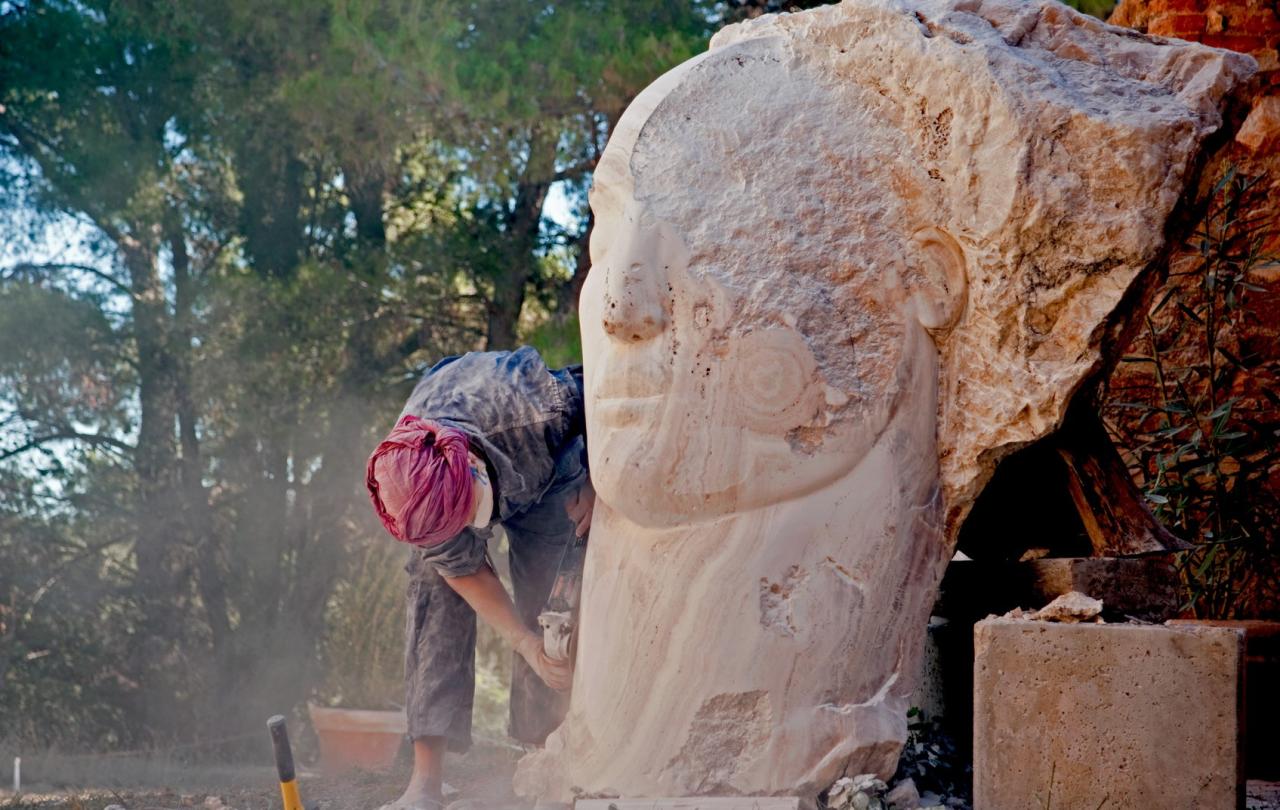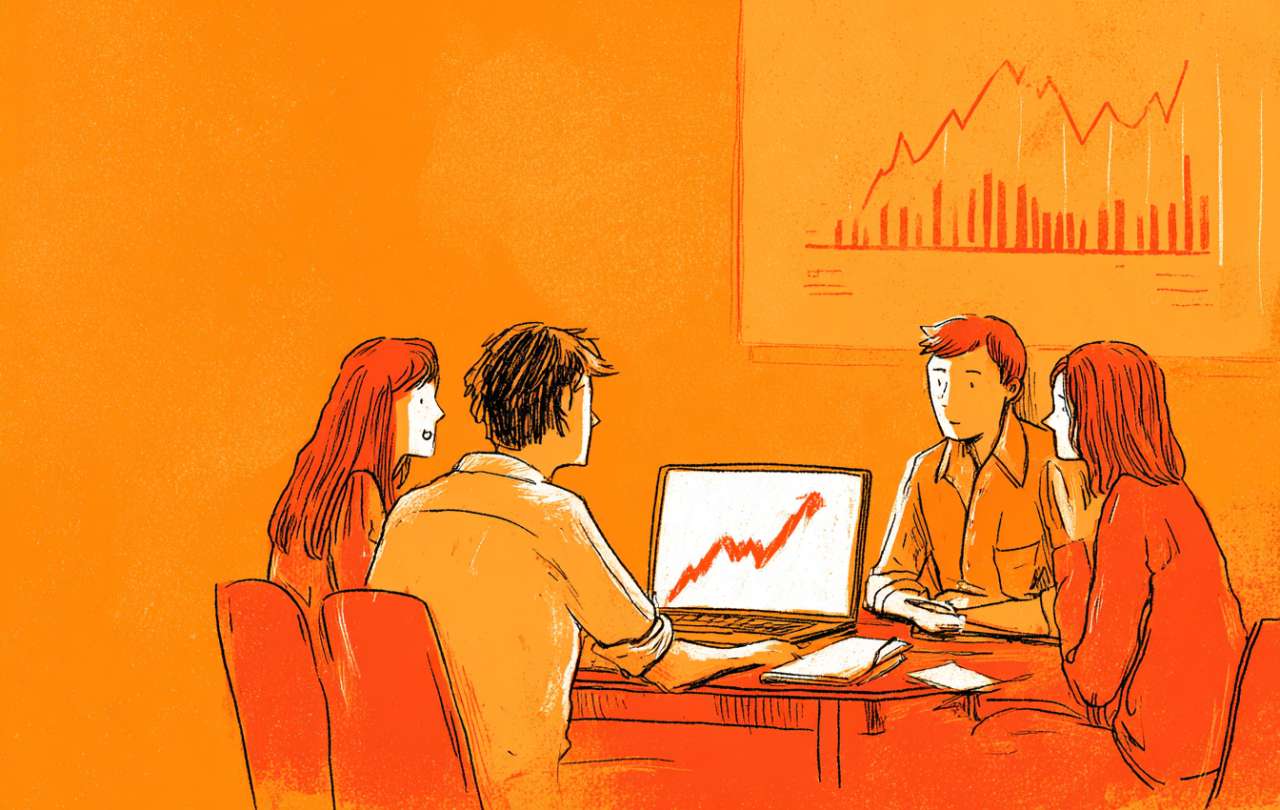
As a painter, Emily Young says she worked relatively quickly in her distinctive surreal style featuring penguins and figures with penguin heads. When she came to sculpture in the 1980s, what she most appreciated was the resistance she felt as she worked, meaning that she ‘had to slow down’ and ‘be super careful’. Right from her first works as a sculptor, the stone was speaking to her, teaching her the value of stillness.
The stones with which she works still speak to her. The stone ‘tells me what it is willing to do’ and ‘lets me know exactly what it can and cannot do, and I work with that’. ‘The stone’, she says, ‘leads me through into this zone where we’re working together’. Ultimately, she says, ‘what I’m showing is that the relationship between a human and the planet can be very, very respectful, and very, very beautiful’. In this way, she uses the beauty, history, and energy of stone to connect people to the natural world.
Her respect for the stones is, in part, because she moves ‘through layers of history in the stones’. Because of their age, stones bring ‘messages to us from a time before culture’; ‘nature has been making stones’ for millions of years meaning that ‘they are from deep time’. This is the ‘stillness of stone compared to me as a short-lived human being’. Her work, therefore, involves ‘throwing something out there that is more enduring than soft humans’.
Her most recent exhibition was entitled ‘Comparative Stillness’. This title was chosen because the way the faces and the bodies she carves ‘always come out, there’s peacefulness there, there’s stillness’. ‘If you sit in this stillness of the stone’, she says, ‘you can find a great joy and a great peace’. She has asked herself, ‘What is it that I’m doing when I’m carving a human head out of stone?’ Her answer is that she is ‘finding an essential core of being alive that has in it, stillness’. ‘It’s the stillness that I’m after’, she says, and ‘out of that stillness come good actions.’ As a result, she says, ‘what I’m completely dedicated to now is to show that we do have access to that stillness and it could be our saving grace’. Everyone, she thinks, ‘should have quiet, kind symbols of internality around them’.
Describing her symbols, she says that: her discs are translucent, holding light within while symbolising the wholeness of the universe; her heads are never of particular people and are embodied consciousnesses with a sweetness to their closed eyes; and her torsos show the beauty and vulnerability of the female form which holds the capacity to create life.
The ‘quietness inherent in stone can also found in our consciousnesses’, which is why she speaks of her stone heads as ‘embodied consciousnesses’. She thinks that religion leads towards this same stillness and, therefore, thinks her art is doing a similar job to that which religion does, ‘trying to give value to people’s lives, what you can and can’t do’. Christ, she says, ‘is a particularly fine example of a teacher’. Her works ‘seem at home within the quietness of churches’ because ‘churches are places that have something of time, deep time’. She has made many sculptures for ecclesiastical settings, including St Paul’s Churchyard and Salisbury Cathedral, while exhibitions of her work have been held at St James Piccadilly and St Pancras New Church.
When I met her, she was in London for the McDonald Agape Lecture in Theology and the Visual Arts 2025. ‘Theology and the Visual Arts: Firming Foundations; Firing Imaginations’ is a five-year project to strengthen the foundations of Theology and the Visual Arts as a discipline within academic Theology, and help to shape its future. The project’s work is showcased to a public audience through major public lectures in an internationally renowned arts venue.
This year’s lecture put Young in dialogue with US painter, Genesis Tramaine, an expressionist devotional painter deeply inspired by biblical texts. Like Young, Tramaine also creates monumental heads, and both speak of being led as they create their works; Young, by the stories in the stones, and Tramaine, by the Holy Spirit following prayer, worship and study of scripture. By being led in their work, both essentially agreed that, as Tramaine put it, you can't be present when creating, instead you ‘have to trust yourself to the process, surrender, and play in the space’. Whether creating the heads of angels or of saints, both are depicting ‘messengers from heaven’.
The good actions that have arisen out of stillness for Young include a project to re-diversify the Maremma seabed in Casa dei Pesci. The seabed in this area, as also in many other places, is being destroyed through illegal fishing by dredger trawlers which destroy the seagrass meadows that are the breeding grounds for marine life. A local fisherman Paolo Fanciulli decided to address the problem by asking artists, including Young, to sculpt huge blocks of Carrara marble as, once these lie on the seabed, they make it impossible for the dredger trawlers to operate in the area. 29 sculptures, including four Stone Guardians by Young, form the Talamone Underwater Museum, which has seen ‘the trawlers go away’ and ‘the seabed diversify’ once again.
Young also creates large sculptures in the grounds of Convento di Santa Croce, the ruined monastery in Tuscany where she now lives. She says she has ‘been quiet’ and ‘become reclusive’ living there because the place itself is ‘really peaceful and quiet’ with a ‘handmade stillness to everything’. When the rains come, ‘bits of the steep hills fall away’ revealing ancient stones formed of volcanic materials, while caves which had fallen in on themselves have filled up with rainwater creating over time ‘a layered geology’. In this way in this area, ‘the earth is giving great stones to work with’.
In this delightful, giving place of stillness, she can sit quietly, prayerfully. She notes ‘how difficult it is to find a place of stillness today because of the ‘cacophony of distraction’ we all experience. Her aim is to show the way we are ‘wasting the gift of life’ and to reveal ‘our one consciousness’ in the stillness of stone.
Support Seen & Unseen
Since Spring 2023, our readers have enjoyed over 1,500 articles. All for free.
This is made possible through the generosity of our amazing community of supporters.
If you enjoy Seen & Unseen, would you consider making a gift towards our work?
Do so by joining Behind The Seen. Alongside other benefits, you’ll receive an extra fortnightly email from me sharing my reading and reflections on the ideas that are shaping our times.
Graham Tomlin
Editor-in-Chief





